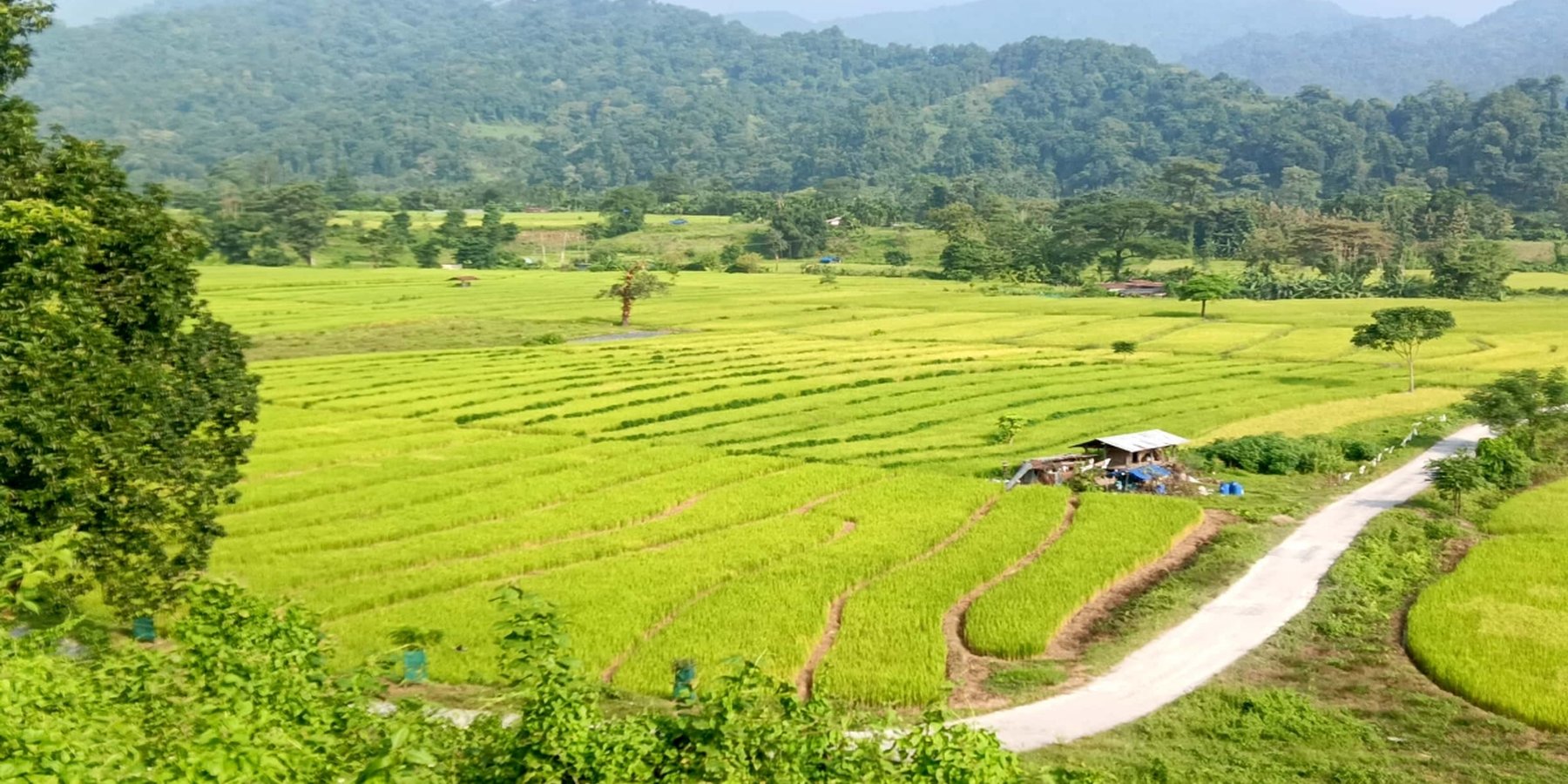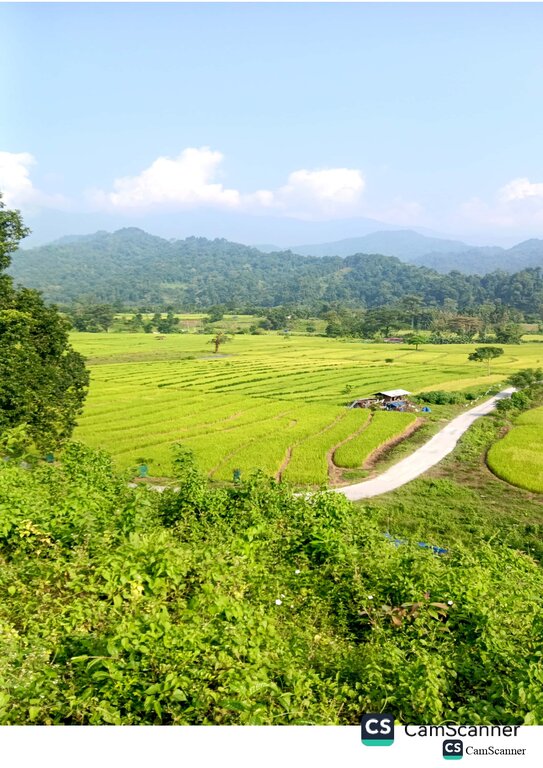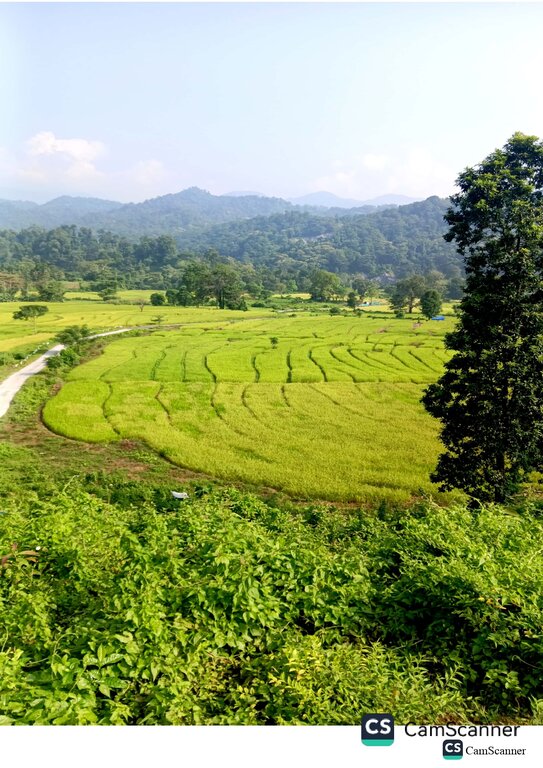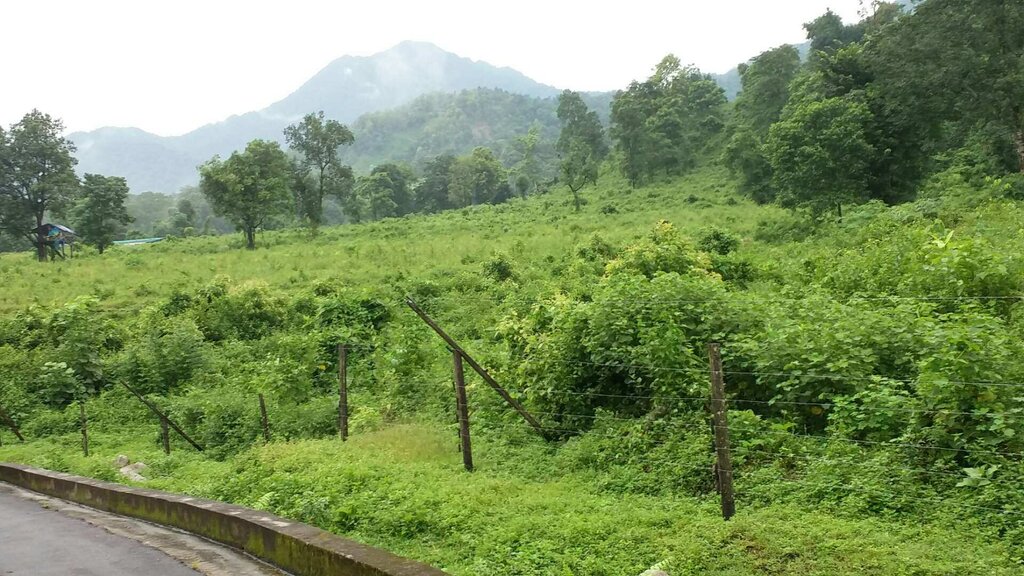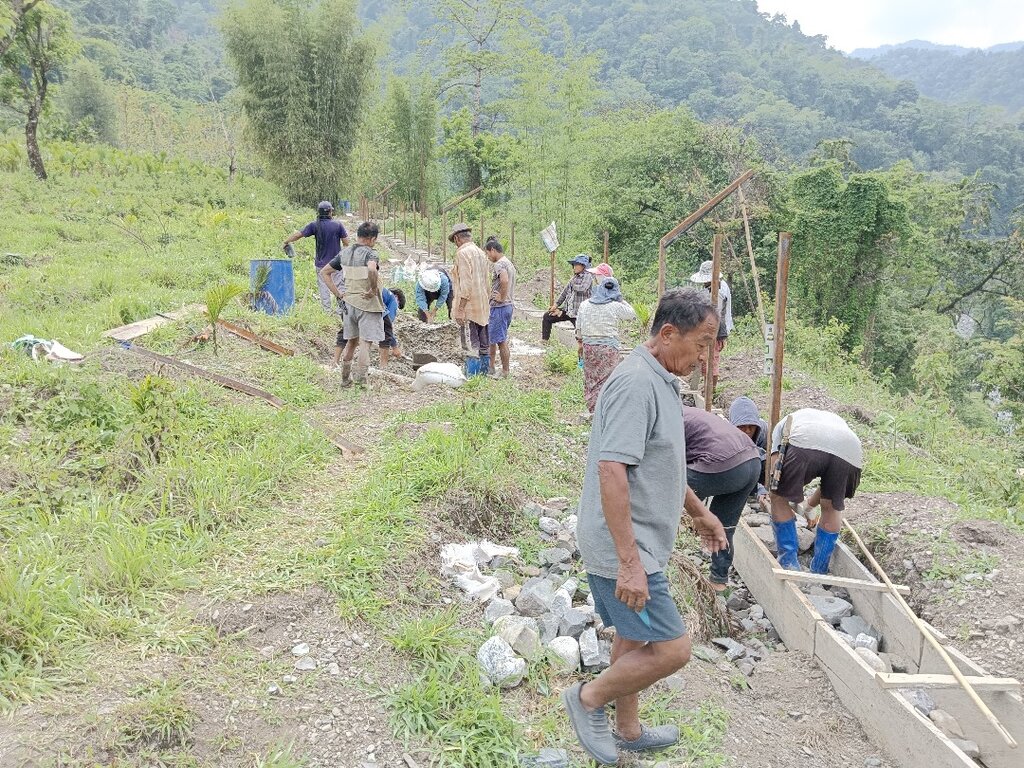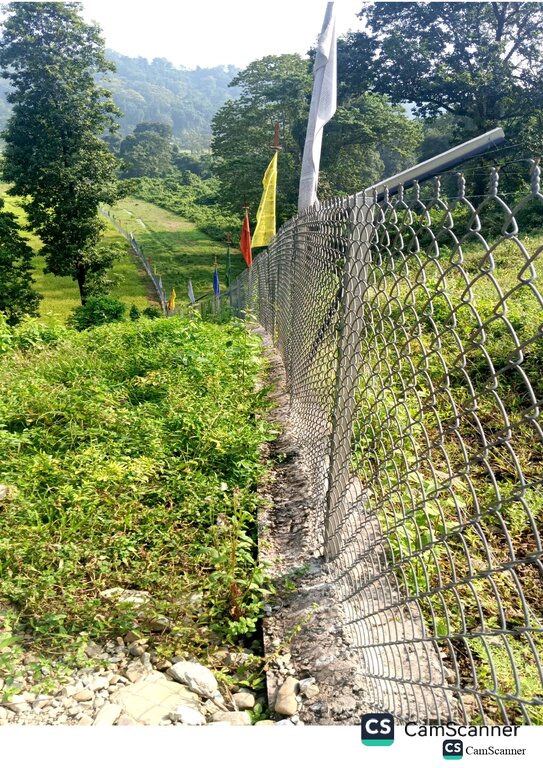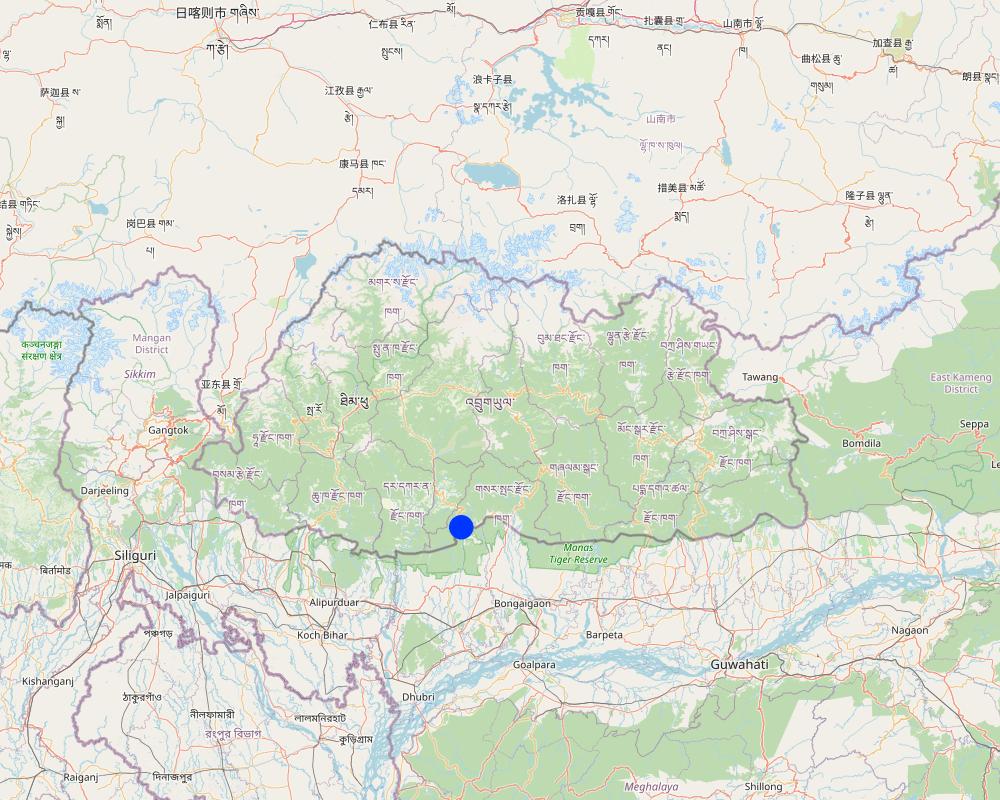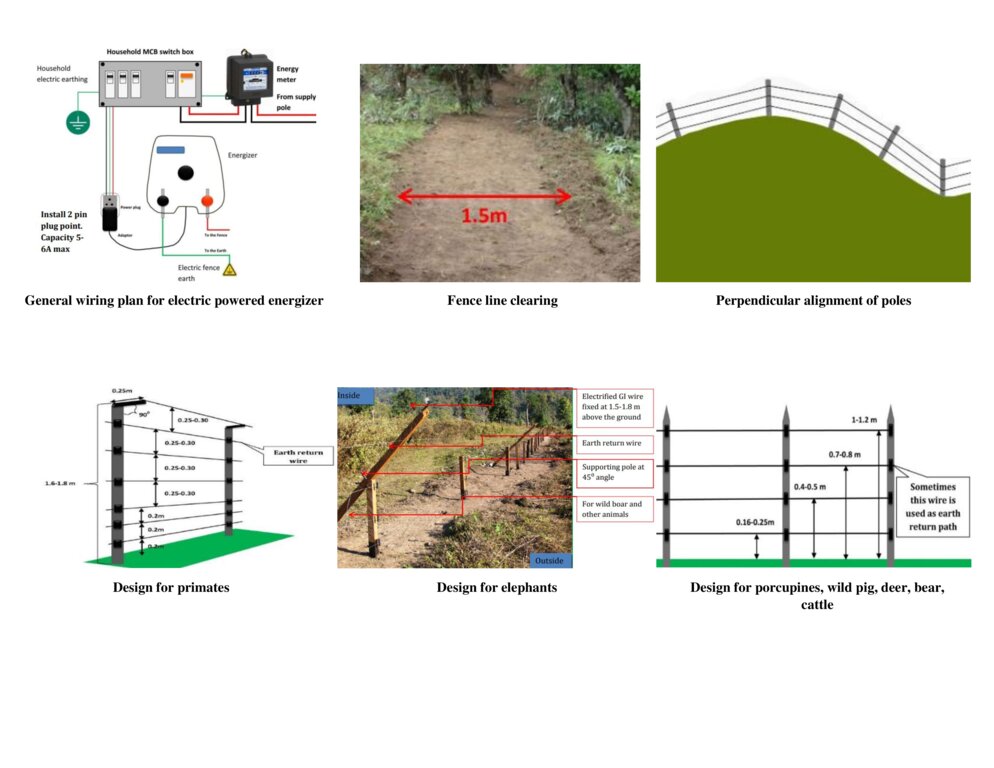Securing Food Through Electric Fencing [不丹]
- 创建:
- 更新:
- 编制者: Nima Dolma Tamang
- 编辑者: Chenga Tshering
- 审查者: William Critchley, Rima Mekdaschi Studer
gLog-May-Raow
technologies_6830 - 不丹
查看章节
全部展开 全部收起1. 一般信息
1.2 参与该技术评估和文件编制的资源人员和机构的联系方式
关键资源人
土地使用者:
Tashi Tshering
不丹
Gewog Agriculture Extension Officer:
Wangdi Thinley
Gewog Agriculture office, Senggye Gewog, Sarpang Dzongkhag
不丹
有助于对技术进行记录/评估的项目名称(如相关)
Strengthening national-level institutional and professional capacities of country Parties towards enhanced UNCCD monitoring and reporting – GEF 7 EA Umbrella II (GEF 7 UNCCD Enabling Activities_Umbrella II)有助于对技术进行记录/评估的机构名称(如相关)
National Soil Services Centre, Department of Agriculture, Ministry of Agriculture & Livestock (NSSC) - 不丹1.3 关于使用通过WOCAT记录的数据的条件
编制者和关键资源人员接受有关使用通过WOCAT记录数据的条件。:
是
1.4 所述技术的可持续性声明
这里所描述的技术在土地退化方面是否存在问题,导致无法被认为是一种可持续的土地管理技术?:
否
注释:
Based on the responses provided by the interviewee (Group Chairman), it appears that electric fences may not directly contribute to mitigating land degradation. However, they can be considered as part of a technological approach, particularly in terms of adaptation, given their effectiveness in land restoration, fallow land reversion, ensuring food security, and ultimately enhancing livelihoods.
2. SLM技术的说明
2.1 技术简介
技术定义:
The Electric Fencing System in Bhutan serves as a non-lethal approach to safeguarding crops from wild animals, aligning with the principles of Gross National Happiness (GNH). GNH emphasizes values such as compassion, non-killing, and harmonious coexistence with nature and its elements.
2.2 技术的详细说明
说明:
The Electric Fencing System in Bhutan serves as a non-lethal approach to safeguarding crops from wild animals, aligning with the principles of Gross National Happiness (GNH). GNH emphasizes values such as compassion, non-killing, and harmonious coexistence with nature.
The National Plant Protection Centre (NPPC), Department of Agriculture (DoA), Ministry of Agriculture and Livestock (MoAL) has been facilitating the application and installation of electric fence systems nationwide. This is achieved through the provision of comprehensive guidelines to help the public comprehend the fundamental components and installation procedures.
In essence, the electric fence system consists of three major parts: Energizers, Insulators, and Earth return. The energizer is responsible for generating high-voltage pulse electricity (ranging from 9-12 KV), which is then delivered along the fence wires. The majority of energizers are directly connected to the electricity line, while in some isolated cases, solar panels and batteries are used as alternative power sources. Insulators are typically crafted from a non-conductive material and serve as a barrier between the electrified wire and the wooden post. In the Bhutanese market, these insulators are not readily available, thus as an alternative, high-density polyethylene (HDPE) pipe has been found to be effective and cheap. The electric fence earth return serves as an essential pathway in the electric circuit, collecting high voltage and current from the earth and returning it to the energizer.
The loss of crops to wild animals leads to increased production costs in Bhutan (time spent in crop guarding) and the expansion of fallow lands. Farmers often resort to illegal and fatal methods of electric fencing, tapping electricity directly from the main line. To address these issues, the implementation of electric fencing, utilizing imported IEC-certified energizers and locally fabricated fencing materials, has proven to be successful. This electric fencing system, introduced after five years of pre-testing across the country, covers various locations targeting different problem species of animals. Not only is this technology effective in controlling wild pests, but it also enjoys high social acceptance among Bhutanese farmers due to its cost-effectiveness and being non-lethal to wild pests.
A recent study on the impact of electric fencing on food security focused on the Laptsakha community in Senggye Gewog, Sarpang Dzongkhag. They faced threats to food security from elephants, boar and stray cattle from neighboring communities in India. Crop production in Laptsakha was negligible before the introduction of electric fencing: resettled households contemplated returning, fertile lands were left fallow, and incomes shrank. The turning point came in 2013 with the introduction of electric fencing. This intervention successfully mitigated wildlife attacks on crops, ensuring food security and contributing to a harmonious ecosystem and improved livelihoods for the people of Laptsakha.
The electric fence, covering a distance of 7 km, protects a total of 60 households in all, safeguarding about 60 (24 ha) acres of vulnerable lands. Electric fences have various benefits including:
•Harmonious Approach: they do not cause harm to animals beyond a repellent shock.
•Economical and Easy to Build: they are cost-effective and relatively easy to construct.
•Learning and Deterrence: animals quickly learn to respect electric fences.
•Durability: they have an extended service life.
•Versatility: they offer a variety of designs and can control a wide range of wild animals.
The installation of an electric fence involves a participatory approach and several key steps:
•Location and Length: determine the location and approximate length of the electric fence either by manual measurement, or remote technologies for larger expanses.
•Material Estimation: estimate the required materials per kilometre based on the identified area, including wooden poles, HDPE pipe, and GI wire.
•Additional Materials: Consider other essential materials like energizers, solar panels, charge controllers, and batteries, depending on the specific requirements.
•Cost Estimation: Calculate the cost of installation, which varies regionally. For example, to instal one kilometre of an electric fence is estimated at about Nu. 7,450 (USD 95) excluding labour costs and cost of wooden poles which is sourced locally.
The implementation of electric fencing in the community has brought significant advantages, particularly in securing food. Prior to this intervention, the community faced severe challenges in harvesting crops, with approximately 70% of fertile lands being left fallow due to constant human-wildlife conflicts. Crop guarding became routine & risky.
With the introduction of electric fences, the community's agricultural landscape has undergone a positive transformation. Crop diversification has been enhanced, encompassing maize, ginger, paddy, mandarin fruit trees and areca nut. The frequency of wild elephant attacks has significantly decreased, leading to a notable increase in crop production. This has resulted in secured food sources and improved livelihoods. Additionally, the community has successfully revived previously fallow lands.
While the electric fencing has proven effective, there are challenges faced by the land users, notably the frequent damage to energizers, primarily attributed to thunderstorms. This has resulted in higher maintenance costs. In one specific instance, the community had to mobilize approximately Nu. 145,000 (USD 1800) independently to replace damaged energizers and other materials, supplementing the continued support from the government.
2.3 技术照片
2.5 已应用该技术的、本评估所涵盖的国家/地区/地点
国家:
不丹
区域/州/省:
Sarpang Dzongkhag
有关地点的进一步说明:
Laptsakha Village, Senggye Gewog
具体说明该技术的分布:
- 适用于特定场所/集中在较小区域
技术现场是否位于永久保护区?:
是
如果是,请具体说明:
The Laptsakha community (electric fencing site) falls under Phibsoo Wildlife Sanctuary.
注释:
The Phibsoo Wildlife Sanctuary, situated in western Sarpang Dzongkhag and south-eastern Dagana Dzongkhag along the border with West Bengal, is the second-smallest national park in Bhutan, covering an area of 268.93 square kilometers. This sanctuary is linked to Jigme Singye Wangchuck National Park and Royal Manas National Park through a biological corridor that crosses a national highway. The elevations within the sanctuary range from 200 meters to 1,600 meters.
Map
×2.6 实施日期
注明实施年份:
2013
2.7 技术介绍
详细说明该技术是如何引入的:
- 通过项目/外部干预
注释(项目类型等):
The electric fencing program in the community was facilitated by the former Renewable Natural Resources and Development Centre (RNR-DC) - Yusipang, now known as the National Center for Organic Agriculture- Yusipang. Additionally, the expertise of the electric fence specialist from ARDC - Wengkhar, Mongar (Eastern Bhutan) was involved in the implementation of the program.
3. SLM技术的分类
3.1 该技术的主要目的
- 改良生产
- 减少、预防、恢复土地退化
- 保持/提高生物多样性
- 创造有益的经济影响
- 创造有益的社会影响
3.2 应用该技术的当前土地利用类型
同一土地单元内混合使用的土地::
是
具体说明混合土地使用(作物/放牧/树木):
- 农林业

农田
- 一年一作
- 多年一作(非木材)
年作 - 具体指明作物:
- 谷物类 - 玉米
- 谷类 - 小米
- 谷类 - 水稻(湿地)
多年生(非木质)作物 - 指定作物:
- 槟榔属
- 菠萝
- Banana, cardamom
每年的生长季节数:
- 2
具体说明:
Maize in summer is followed by chilli in winter.
采用间作制度了吗?:
是
如果是,说明哪些作物是间作的:
The people of Laptsakha cultivate paddy (wetland) and soybean simultaneously. The soybean is grown along the terrace bunds, especially as a border crop.
采用轮作制度了吗?:
是
如果是,请具体说明:
The maize harvest is followed by chilli cultivation

森林/林地
- (半天然)天然森林/林地
(半天然)天然森林/林地:具体说明管理类型:
- 选伐
- 非木材森林的利用
(半)天然林类型:
- 亚热带湿润林天然植被
- Mixed broad leaves
以上的树木是落叶树还是常绿树?:
- 混合落叶或常绿
产品和服务:
- 木材
- 薪材
- 放牧/啃牧
3.3 由于技术的实施,土地使用是否发生了变化?
由于技术的实施,土地使用是否发生了变化?:
- 否(继续问题3.4)
注释:
The introduction of electric fencing in the community has not led to a change in land use patterns. However, there has been a notable transformation in land cover over the years. Prior to the implementation of electric fencing, approximately 70% of the currently cultivated lands (comprising 325 acres, including 168 acres of dry land and 157 acres of wetland) were left fallow due to the threat of wildlife (human-wildlife conflict). The introduction of electric fencing has played a crucial role in revitalizing these fertile fallow lands, bringing them back into cultivation.
3.4 供水
该技术所应用土地的供水:
- 混合雨水灌溉
注释:
The community is well-equipped with two full-time irrigation sources: Mahajan Irrigation and Ghantay Irrigation canals. However, the reliance on irrigation is reduced when there is sufficient rainfall. Therefore, they describe the irrigation system as a mixed approach, combining both irrigation sources and rainwater.
3.5 该技术所属的SLM组
- 天然和半天然森林管理
- 病虫害综合管理(包括有机农业)
- 湿地保护/管理
3.6 包含该技术的可持续土地管理措施

结构措施
- S6:墙、障碍物、栅栏、围墙
- S10:节能措施
注释:
The electric fence can be a structural measure that ensures energy savings due to its versatility (solar and electric-power options). It can be also considered as one of the structural measures ensuring a harmonious environment.
3.7 该技术强调的主要土地退化类型

生物性退化
- Bc:植被覆盖的减少
- Bh:栖息地丧失
- Bq:数量/生物量减少
注释:
The electric fencing ensures harmonious environment for wild life. Their lives are prevented from fatal threats being attempted by farmers in controlling wild pests. Hence, they are dedicated with the safe habitats, which ultimately results in enhanced bio-diversity.
3.8 防止、减少或恢复土地退化
具体数量名该技术与土地退化有关的目标:
- 防止土地退化
- 减少土地退化
注释:
The electric fence plays an important role in preventing and reducing land degradation. The lands encompassed within the electric fence are well managed and put to good use (higher ground coverage with year-round cultivation, proper nutrient management, and others). Caring for these productive lands encircled by electric fencing thereby either prevents or reduces land degradation ultimately.
4. 技术规范、实施活动、投入和成本
4.1 该技术的技术图纸
技术规范(与技术图纸相关):
Insulators are prepared using HDPE pipes (32 mm or 25 mm in diameter, with a pressure capacity of 10 kg/cm2). These pipes are cut into 10-11 cm lengths, with holes drilled at the center, and then secured with two 3-inch nails at both ends, maintaining a 1.50 cm distance from edges. The fencing process involves clearing a fence line with a width of at least 1.5 m. Wooden poles (10 to 18 cm in diameter) are erected perpendicular to the ground, spaced 2.5 to 3 m apart in flat lands and 2 m or less in sloped areas.
For fences designed to control smaller species like rabbits and porcupines, the first wire is positioned about 0.14 to 0.16 m from the ground. Fences for larger animals such as wild boars, deer, and bears require 3 to 4 strands of wires positioned at 0.25, 0.4 to 0.5, 0.7 to 0.8, and 1 to 1.2 m from the ground. In the case of elephants, one or two strands of wire should be positioned at 1.5 to 1.8 m from the ground, and supporting poles should be erected at 45-degree angles from the entrance side of the field.
The height of the fence is adapted based on the target animals, such as monkeys. Typically, the 7th strand is supported on a 25 cm HDPE pipe fixed on top of the wooden pole at a 90-degree angle to the entrance side of the field. This design prevents monkeys from climbing the wooden posts and jumping into the field.
作者:
National Plant Protection Centre (NPPC), DoA, MoAL
日期:
08/07/2023
4.2 有关投入和成本计算的一般信息
具体说明成本和投入是如何计算的:
- 每个技术单元
指定单位:
kilometre
其它/国家货币(具体说明):
Ngultrum (Nu.)
如相关,注明美元与当地货币的汇率(例如1美元=79.9巴西雷亚尔):1美元=:
80.0
注明雇用劳工的每日平均工资成本:
250
4.3 技术建立活动
| 活动 | 时间(季度) | |
|---|---|---|
| 1. | Area identification through Google Map by ARDC-Yusipang | 2013, Winter |
| 2. | Cleaning of vegetation along the identified fence line (10 m width) | 2013, Winter (after crop harvest) |
| 3. | Ground clearing and levelling (2 m width) | 2013, Winter (after crop harvest) |
| 4. | Gathering of fencing poles | 2013, Winter (after crop harvest) |
| 5. | Procurement and facilitation of materials (energizers, solar panels, nails, GI wire, insulation pipes) | 2013, Winter (after crop harvest) |
| 6. | Execution of fencing activities | 2013, Winter (after crop harvest) |
注释:
The actual electric fencing works in Laptsakha, measuring a distance of seven kilometres was completed in less than a month. Better community cooperation was a major reason behind this success, as per the Group's chairman.
4.4 技术建立所需要的费用和投入
| 对投入进行具体说明 | 单位 | 数量 | 单位成本 | 每项投入的总成本 | 土地使用者承担的成本% | |
|---|---|---|---|---|---|---|
| 劳动力 | Man | Person-days | 1600.0 | 250.0 | 400000.0 | 100.0 |
| 设备 | Energizer | No. | 6.0 | 9500.0 | 57000.0 | |
| 设备 | GI wire (SWG 16) | Kg | 356.0 | 95.0 | 33820.0 | |
| 设备 | Nail (3 inch) | Kg | 106.0 | 82.0 | 8692.0 | |
| 设备 | Solar Panel (20 watts) | No. | 6.0 | 7000.0 | 42000.0 | |
| 设备 | Charge controller | No. | 6.0 | 1800.0 | 10800.0 | |
| 设备 | Acidic Battery | No. | 6.0 | 2800.0 | 16800.0 | |
| 设备 | Lubricants (Gear oil) | Litre | 6.0 | 254.0 | 1524.0 | |
| 设备 | Insulators (HDPE pipe [32 mm]) | Metre | 781.0 | 48.0 | 37488.0 | |
| 施工材料 | Wooden poles | No. | 1400.0 | 100.0 | ||
| 其它 | Other accessories | NA | 1.0 | 1000.0 | 1000.0 | |
| 技术建立所需总成本 | 609124.0 | |||||
| 技术建立总成本,美元 | 7614.05 | |||||
如果土地使用者负担的费用少于100%,请注明由谁负担其余费用:
National Centre for Organic Agriculture, Yusipang
注释:
The labour contribution was from Laptsakha and Nichula villages as the electric fencing benefitted both villages. Therefore, a higher number of land users are involved in the construction of the technology.
The total cost for the establishment of the technology is USD 7614.05 for 7 km (USD 1087.7 for 1 km). This includes labour cost which is borne by the land users.
4.5 维护/经常性活动
| 活动 | 时间/频率 | |
|---|---|---|
| 1. | Replacement of energizers during breakdowns | As and when breakdown occurs |
| 2. | Fence line clearing | Monthly |
注释:
Between 2013 and 2019, approximately 20 energizer sets had to be replaced due to thunderstorm damage. To address this issue, the community transitioned to using solar-powered energizers instead of electricity, proving to be a more effective solution. Double batteries were employed to ensure consistent current flow during cloudy days. As part of the routine maintenance, the clearing of the fence line became a monthly task, with each household assigned an area of approximately 116 meters to manage.
4.6 维护/经常性活动所需要的费用和投入(每年)
| 对投入进行具体说明 | 单位 | 数量 | 单位成本 | 每项投入的总成本 | 土地使用者承担的成本% | |
|---|---|---|---|---|---|---|
| 劳动力 | Labor | Person-days | 59.0 | 700.0 | 41300.0 | 100.0 |
| 技术维护所需总成本 | 41300.0 | |||||
| 技术维护总成本,美元 | 516.25 | |||||
如果您无法分解上表中的成本,请估算维护该技术所需要的总成本。:
145000.0
注释:
The beneficiaries covered the cost of acquiring the damaged energizers through monthly contributions of Nu. 200 per household and other penalty revenues. The total costs for maintenance of the technology is USD 516.25 for 7 km ( USD 73.75 for 1 km).
4.7 影响成本的最重要因素
描述影响成本的最决定性因素:
The primary factor incurring the cost, according to the beneficiaries, was the energizer set, which necessitates frequent replacement.
5. 自然和人文环境
5.1 气候
年降雨量
- < 250毫米
- 251-500毫米
- 501-750毫米
- 751-1,000毫米
- 1,001-1,500毫米
- 1,501-2,000毫米
- 2,001-3,000毫米
- 3,001-4,000毫米
- > 4,000毫米
有关降雨的规范/注释:
The most recent climate data 2017, published by NCHM was used.
注明所考虑的参考气象站名称:
Station: Bhur, Type: Class A, Station ID: 23310046
农业气候带
- 潮湿的
The area falls under the humid subtropical zone from the six Agro-ecological zones in Bhutan.
5.2 地形
平均坡度:
- 水平(0-2%)
- 缓降(3-5%)
- 平缓(6-10%)
- 滚坡(11-15%)
- 崎岖(16-30%)
- 陡峭(31-60%)
- 非常陡峭(>60%)
地形:
- 高原/平原
- 山脊
- 山坡
- 山地斜坡
- 麓坡
- 谷底
垂直分布带:
- 0-100 m a.s.l.
- 101-500 m a.s.l.
- 501-1,000 m a.s.l.
- 1,001-1,500 m a.s.l.
- 1,501-2,000 m a.s.l.
- 2,001-2,500 m a.s.l.
- 2,501-3,000 m a.s.l.
- 3,001-4,000 m a.s.l.
- > 4,000 m a.s.l.
说明该技术是否专门应用于:
- 不相关
关于地形的注释和进一步规范:
The gentle plain dominates the area with a slope ranging from 2 to 5 per cent.
5.3 土壤
平均土层深度:
- 非常浅(0-20厘米)
- 浅(21-50厘米)
- 中等深度(51-80厘米)
- 深(81-120厘米)
- 非常深(> 120厘米)
土壤质地(表土):
- 粗粒/轻(砂质)
土壤质地(地表以下> 20厘米):
- 粗粒/轻(砂质)
表土有机质:
- 高(>3%)
如有可能,附上完整的土壤描述或具体说明可用的信息,例如土壤类型、土壤酸碱度、阳离子交换能力、氮、盐度等。:
Moisture content 3.31%, organic matter 7.16%, Organic carbon 4.16%, pH 6.81, electrical conductivity 261.97 µs/cm, nitrogen 0.21%, phosphorus 0.34 ppm, Potassium 201.07 mg/100ml, texture sand clay loam.
The soil analysis was conducted at the Science Laboratory of College of Natural Resources, Royal University of Bhutan, Lobesa, Punakha.
5.4 水资源可用性和质量
地表水的可用性:
好
水质(未处理):
良好饮用水
水质请参考::
地表水
水的盐度有问题吗?:
否
该区域正在发生洪水吗?:
否
5.5 生物多样性
物种多样性:
- 高
栖息地多样性:
- 高
关于生物多样性的注释和进一步规范:
The rich periphery environment, higher vegetation coverage, and evident agroforestry indicate high species and habitat diversity.
5.6 应用该技术的土地使用者的特征
定栖或游牧:
- 定栖的
生产系统的市场定位:
- 混合(生计/商业)
非农收入:
- 低于全部收入的10%
相对财富水平:
- 平均水平
个人或集体:
- 团体/社区
机械化水平:
- 机械化/电动
性别:
- 女人
- 男人
土地使用者的年龄:
- 青年人
- 中年人
5.7 应用该技术的土地使用者使用的平均土地面积
- < 0.5 公顷
- 0.5-1 公顷
- 1-2 公顷
- 2-5公顷
- 5-15公顷
- 15-50公顷
- 50-100公顷
- 100-500公顷
- 500-1,000公顷
- 1,000-10,000公顷
- > 10,000公顷
这被认为是小规模、中规模还是大规模的(参照当地实际情况)?:
- 小规模的
- 大规模的
注释:
The average land holding area of native households accounts for about 2 acres, falling under small-scale referring to the local context.
However, the land holding area of re-settled households in the community is 5 acres, falling under medium-scale referring to the local context.
The average household land holding in Bhutan is 3.4 acres. Therefore, the land users owning more than 3.4 acres are categorized as large-scale and less than 3.4 acres are categorized as small-scale.
5.8 土地所有权、土地使用权和水使用权
- Family land ownership
土地使用权:
- 个人
用水权:
- 社区(有组织)
土地使用权是否基于传统的法律制度?:
是
具体说明:
The land use rights in Bhutan is traditional legal system guided by formal land act and land rules and regulations.
5.9 进入服务和基础设施的通道
健康:
- 贫瘠
- 适度的
- 好
教育:
- 贫瘠
- 适度的
- 好
技术援助:
- 贫瘠
- 适度的
- 好
就业(例如非农):
- 贫瘠
- 适度的
- 好
市场:
- 贫瘠
- 适度的
- 好
能源:
- 贫瘠
- 适度的
- 好
道路和交通:
- 贫瘠
- 适度的
- 好
饮用水和卫生设施:
- 贫瘠
- 适度的
- 好
金融服务:
- 贫瘠
- 适度的
- 好
注释:
The community is striving for the upgradation of the present primary school to high school.
6. 影响和结论性说明
6.1 该技术的现场影响
社会经济效应
生产
作物生产
SLM之前的数量:
219 kg paddy from one acre wetland
SLM之后的数量:
1090 kg of paddy from one acre wetland
注释/具体说明:
There is a significant increase in the crop production. The production before electric fencing was almost zero due to wild elephant attacks. However, the issue is resolved due to the electric fence intervention.
作物质量
注释/具体说明:
The beneficiaries believe that the quality of the crop has improved based on visual observation and sensory evaluations (taste). This could be due to reduced trampling of the crop by wild animals.
生产故障风险
SLM之前的数量:
20% of paddy harvest from one acre wetland
SLM之后的数量:
100% of paddy harvest from one acre wetland
注释/具体说明:
The human-wildlife conflict was the major factor causing production failure in the past. The risk of production failure is reduced by 100% as the land is secured from wild animal intrusion.
产品多样性
SLM之前的数量:
Ginger cultivation was not possible
SLM之后的数量:
Now the land users cultivates ginger
注释/具体说明:
Ginger cultivation before electric fencing was not possible due to wild elephants straggling in the fields. Currently, the land users grow ginger leading to product diversity.
生产区域
注释/具体说明:
A major portion of the arable land was not cultivated in the past due to wild animal depredation, now the land users engage in various agricultural activities in that land.
土地管理
注释/具体说明:
The electric fencing technology has made the land suitable for agricultural activities. Motivating the land users to manage the land better by sourcing irrigation and reducing land degradation. However, the land users are not able to manage landslides in the area.
收入和成本
农业投入费用
注释/具体说明:
The expenditure of money and time to guard the field is significantly reduced as the crop destruction by wild animals was eradicated with electric fence intervention.
农业收入
注释/具体说明:
The technology enabled the land users to engage in commercial farming. Further, the time required to guard the crop can be dedicated to other productive farm activities.
收入来源的多样性
注释/具体说明:
The land users are engaged in diverse crop cultivation leading to diversified income sources.
工作量
注释/具体说明:
The workload involved in guarding the crop is significantly reduced.
社会文化影响
食品安全/自给自足
注释/具体说明:
The land users in the Laptsakha community are self-sufficient in cereals and most vegetables. Before the technology introduction, the land users were not involved in cultivation of crops and approximately 70% of the land was left fallow. The land users were dependent on imported food products. However, the technology has enabled farming activities including cereals and vegetable production making the land users self-sufficient. The surplus produce is sold in the market fetching good income with which the land users can purchase quality food products that are not grown in the field increasing the food security of the community.
健康状况
注释/具体说明:
The land users believe that the health situation of the community has improved. The possible reason could be due to the consumption of diverse and organic food products available from their field.
文化机会
注释/具体说明:
The electric fencing has added aesthetic value to the community, where community has been recognized as one of the successful electric fencing pilot sites. Moreover, external visitors are attracted to witness the success of the community.
Also, the community bond has been strengthened, through a approach like labour sharing instituted during the implementation of the technology.
娱乐机会
注释/具体说明:
The time required to guard the field previously can be utilized in recreational activities.
SLM/土地退化知识
注释/具体说明:
The electric fence and land degradation do not exhibit a direct relationship. However, the technology encourages the land user to value their land and implement management practices ultimately improving the knowledge and skills SLM.
冲突缓解
注释/具体说明:
There is a significant improvement in human-wildlife conflict management.
社会经济弱势群体的情况
注释/具体说明:
Disadvantaged land users having inadequate human resources benefit from the technology leading to improved situation of the household.
生态影响
生物多样性:植被、动物
植被覆盖
注释/具体说明:
The land users' involvement in the destruction of the forest cover surrounding the farm is reduced. The practice was aimed at chasing wild animals. However, with the reduction of this practice, there is higher vegetation cover.
生物量/地上C
注释/具体说明:
There is enhanced vegetation cover in the surrounding forest and on the crop land leading to increased biomass.
栖息地多样性
注释/具体说明:
The destruction of natural habitats has been reduced due to least forest-poaching .
6.2 该技术的场外影响已经显现
Biological diversity conservation outside farmland
注释/具体说明:
The area protected by the electric fencing covers farmland and forest areas. Therefore, the flora diversity is improved as it is not lost to wildlife depredation.
6.3 技术对渐变气候以及与气候相关的极端情况/灾害的暴露和敏感性(土地使用者认为的极端情况/灾害)
渐变气候
渐变气候
| 季节 | 增加或减少 | 该技术是如何应对的? | |
|---|---|---|---|
| 年温度 | 增加 | 未知 |
气候有关的极端情况(灾害)
气象灾害
| 该技术是如何应对的? | |
|---|---|
| 局地暴雨 | 非常好 |
| 局地雷暴 | 不好 |
| 局地风暴 | 非常好 |
水文灾害
| 该技术是如何应对的? | |
|---|---|
| 山洪暴发 | 非常不好 |
| 滑坡 | 非常不好 |
注释:
As per the interviewee, the annual rainfall has remained constant over the past decade. However, there has been a noticeable shift in the rainfall pattern, characterized by erratic rainfall. In previous years, the rainfall followed a seasonal pattern, which is no longer consistent in recent times.
6.4 成本效益分析
技术收益与技术建立成本相比如何(从土地使用者的角度看)?
短期回报:
非常积极
长期回报:
非常积极
技术收益与技术维护成本/经常性成本相比如何(从土地使用者的角度看)?
短期回报:
非常积极
长期回报:
非常积极
6.5 技术采用
- > 50%
如若可行,进行量化(住户数量和/或覆盖面积):
The 7 km electric fencing program has benefitted 60 households.
在所有采用这项技术的人当中,有多少人是自发的,即未获得任何物质奖励/付款?:
- 0-10%
注释:
The initial establishment was done through external support by covering the whole community catchment area. One-time maintenance involving the cost of Nu. 145,000/- was initiated by the community by mobilizing their fund.
6.6 适应
最近是否对该技术进行了修改以适应不断变化的条件?:
是
其它(具体说明):
Due to target animal species
具体说明技术的适应性(设计、材料/品种等):
The existing electric fence, operational up to now, underwent significant modifications, incorporating a chain-link fence valued at 1.10 million between February and May 2023. This alteration is intended to deter active wildlife pests, specifically monkeys and elephants.
6.7 该技术的优点/长处/机会
| 土地使用者眼中的长处/优势/机会 |
|---|
| Electric fencing aligns with the convictions of the land users, avoiding harm to wildlife as a means of protecting the land from wild animals. |
| Scaring wild animals with a mild electric shock, the technology deters them from approaching due to the fear of the electric shock from the fence. |
| Creating a favorable environment for agricultural activities, the technology encourages land users to participate in farming, resulting in increased production and household income. |
| 编制者或其他关键资源人员认为的长处/优势/机会 |
|---|
| Reduced risk of loss of life: Wild animals, particularly elephants, pose a threat to the lives of land users, with some reported fatalities. The technology can help mitigate or prevent such incidents. |
| The replication of this technology can eliminate fatal attempts made by land users in various parts of the country to control wild pests. |
6.8 技术的弱点/缺点/风险及其克服方法
| 土地使用者认为的弱点/缺点/风险 | 如何克服它们? |
|---|---|
| Continuous break down of energizers has incurred high maintenance costs | Solar-powered fencing has been the best alternative as implemented by the community. |
| Clearing of the land under the fence is labourious and time consuming. | Timely monitoring of the clearing activity should be done. |
| 编制者或其他关键资源人员认为的弱点/缺点/风险 | 如何克服它们? |
|---|---|
| The GI wire experiences swift rusting. | Timely greasing and utilizing superior quality GI wire. |
7. 参考和链接
7.1 信息的方法/来源
- 实地考察、实地调查
The key informants were the agriculture Extension Agent, and the Chairman of the electric fencing group.
- 与土地使用者的访谈
Chairman represented the group, as per the indication from Agriculture extension agent.
- 根据报告和其他现有文档进行编译
The manuals and guidelines developed by the National Plant Protection Centre (NPPC), Bhutan was referred for general background information.
(现场)数据是什么时候汇编的?:
07/07/2023
7.3 链接到网络上的相关信息
标题/说明:
Technical Reference Manual for installation and maintenance of Electric Fence, National Plant Protection Centre (NPPC), n.d.
URL:
https://www.nppc.gov.bt/electric-fencing-manual/
标题/说明:
Implementation Guidelines for Electric Fencing System, National Plant Protection Centre (NPPC), 2015
URL:
https://www.nppc.gov.bt/electric-fencing-manual/
标题/说明:
EF accessories, National Plant Protection Centre (NPPC), 2015
URL:
https://www.nppc.gov.bt/ef-accessories/
7.4 一般注释
The questionnaire is not easy to apply for such technology in terms of sections 2.5 and 4.2. Under section 2.5 “specify the spread of the technology” the options are not applicable for this technology implemented in 7 km length. Under section 4.2. it is difficult to specify units for the cost calculation. The cost for overall technology implementation can be added. However, the cost specified in km is not uniform. For example, the cost for 1 km could be USD 95 but for 2 km it will be less than USD 190 as there is no need for two energizers and other accessories.
链接和模块
全部展开 全部收起链接
无链接
模块
无模块


